
Nepal Airlines Corporation, formerly known as Royal Nepal Airlines, is Nepal’s flag carrier and a significant player in the nation’s aviation sector. With a history dating back to 1958, the airline has experienced various phases of growth, technological advancements, and challenges. This article, ‘Nepal Airlines Corporation History,’ unearthed the rich history of Nepal’s premier airline, its evolution from a royal entity to a public corporation, its strategic partnerships, and its impact on tourism and the economy of Nepal.
Key Takeaways
- Royal Nepal Airlines was established in July 1958, starting with a Douglas DC-3, and evolved into Nepal Airlines Corporation, reflecting the nation’s aviation growth.
- The airline’s fleet has seen significant evolution, from STOL aircraft to modern Airbus jets, indicating a focus on technological advancement and diversification.
- Strategic partnerships with international airlines and expansion to remote destinations have been crucial to the airline’s development and service offerings.
- Nepal Airlines has faced challenges such as competition, government privatization efforts, and corruption scandals, which have shaped its current structure.
- The airline plays a pivotal role in promoting tourism and contributing to Nepal’s national economy, with Tribhuvan International Airport as its main operational hub.

The Inception and Growth of Royal Nepal Airlines
Establishment and Early Fleet
The inception of Royal Nepal Airlines marked a significant milestone in the aviation sector of Nepal. With a modest beginning, the airline’s fleet was initially limited but strategically chosen to serve the rugged terrain of the Himalayan nation. The early fleet played a crucial role in connecting remote regions, fostering both economic growth and social integration.
Fleet size and destinations were modest at the outset, reflecting the nascent stage of the airline industry in Nepal. However, the commitment to expansion was evident, with plans to enhance the Nepal Airlines fleet and improve services like Nepal Airlines check-in processes. The table below provides a snapshot of the initial fleet composition:
| Aircraft Type | Number in Fleet | Notable Features |
|---|---|---|
| Douglas DC-3 | 2 | STOL Capabilities |
| Fokker F27 | 1 | Pressurized Cabin |
The focus on a customer-centric approach from the beginning laid the foundation for a robust national carrier that would eventually transition to Nepal Airlines Corporation.

As the airline grew, so did the expectations of its passengers. Enhancements in services, including streamlined check-in procedures, were implemented to ensure a seamless travel experience. The dedication to service quality and operational efficiency has been a consistent theme throughout the airline’s history.
Expansion of Domestic and International Routes
As Nepal Airlines expanded its wings, the ease of making a Nepal Airlines booking became a testament to its growth. The airline’s network blossomed to include a variety of both domestic and international destinations, catering to the needs of travelers seeking to explore the beauty of Nepal and beyond. Nepal Airlines online booking systems streamlined the process, allowing passengers to secure their travel plans with just a few clicks.
With a fleet that now flies to 11 international and several domestic destinations, the convenience of checking the Nepal Airlines flight status and Nepal Airlines schedule has significantly improved the travel experience. The airline’s commitment to customer satisfaction is evident in the comprehensive services it offers, from Nepal Airlines ticket bookingto ensuring a generous Nepal Airlines baggage allowance.
Nepal Airlines’ dedication to customer service extends beyond the skies. The airline’s customer service team is always ready to assist with any inquiries, and the Nepal Airlines contact number and Nepal Airlines official website provide easy access to information and support. Additionally, Nepal Airlines promotions aim to make air travel more accessible and affordable.
Passengers have expressed their satisfaction with the airline’s services through Nepal Airlines reviews, which often highlight the airline’s reliability and hospitality. For those looking to reach out directly, the Nepal Airlines contact numberis readily available, and the airline’s customer service representatives are known for their helpfulness and expertise.

Transition to Nepal Airlines Corporation
The transition from Royal Nepal Airlines to Nepal Airlines Corporation marked a significant shift in the airline’s governance and strategy. The Government of Nepal’s decision to sell a 49% stake to the private sector in 2004 was a pivotal moment, aimed at revitalizing the airline by attracting private investment to alleviate its substantial debt. This move retained a 51% share for the government, ensuring continued national ownership.
The restructuring was not without its challenges, including management issues and corruption scandals. The former chairman, Ramagya Chaturvedi, faced legal consequences for corruption, highlighting the need for stringent oversight.
Nepal Airlines Corporation has since endeavored to enhance its services, including Business Class amenities such as special check-in, priority baggage handling, and comfortable seating. The airline’s commitment to improving passenger experience is evident in its ongoing efforts to modernize and expand its fleet.
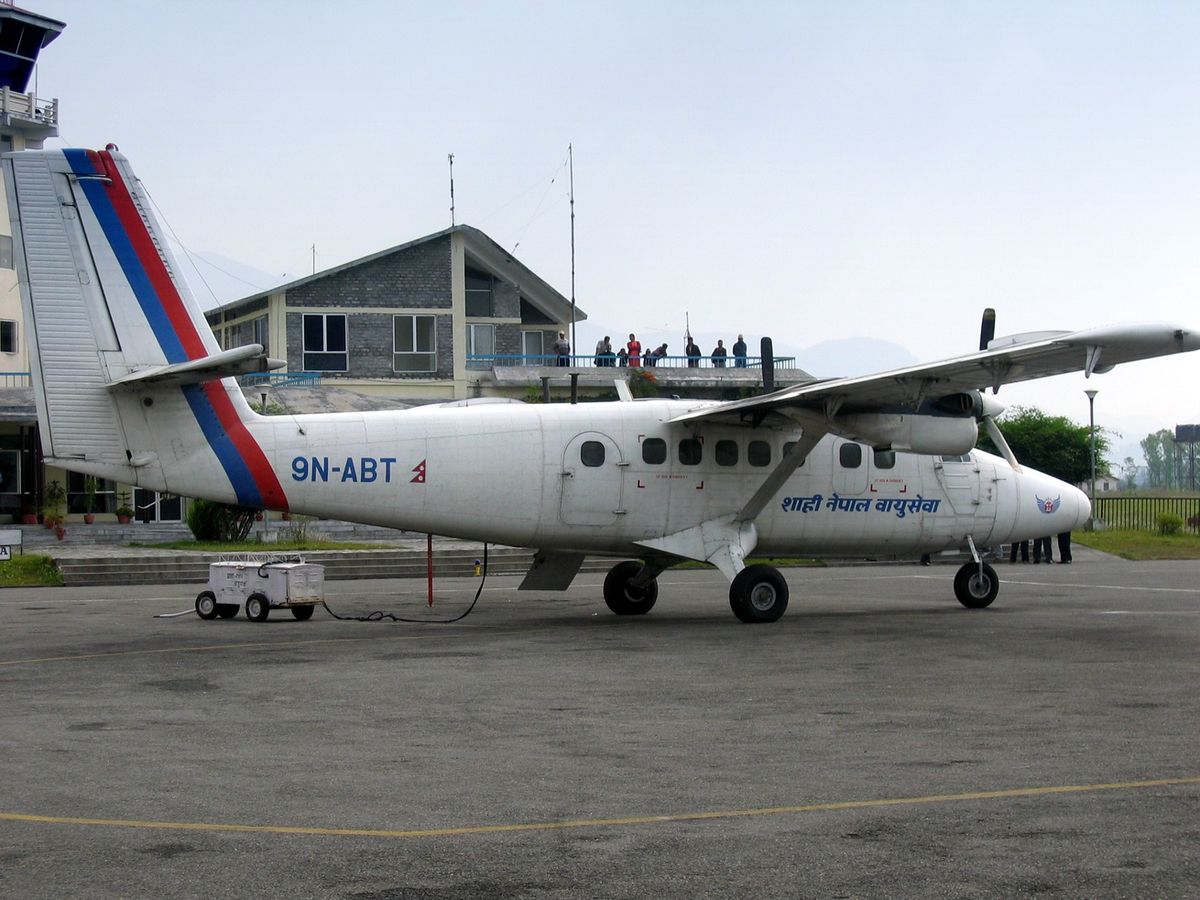
Fleet Evolution and Technological Advancements
Introduction of STOL Aircraft
The introduction of STOL (Short Takeoff and Landing) aircraft marked a significant milestone for Nepal Airlines, enhancing its ability to serve the challenging topography of Nepal. These aircraft were pivotal in connecting remote regions, where conventional planes could not operate due to short and rugged airstrips.
STOL aircraft enabled the expansion of services to areas previously inaccessible by air, fostering economic growth and social integration. The fleet’s versatility was further demonstrated through various roles, including passenger transport, cargo delivery, and emergency services.
The adaptability of STOL aircraft to diverse operational needs has been a cornerstone in the development of Nepal’s aviation sector.
The table below summarizes the key specifications and roles of STOL aircraft in Nepal Airlines’ fleet:
| Aircraft Type | Roles | Key Specifications |
|---|---|---|
| DHC-6 Twin Otter | Passenger, Cargo, Emergency | STOL Capabilities, Rugged Design |
| Pilatus Porter PC-6 | Passenger, Cargo | Single Engine, STOL Capability |
| BAe 748 | Passenger, Cargo | Short-field Performance, Durability |

Modernization with Boeing Aircraft
The modernization of Nepal Airlines’ fleet marked a significant milestone with the introduction of Boeing aircraft. The Boeing 757 became a game-changer for the airline, offering enhanced capabilities for both passenger and cargo services. This single-aisle, short-medium range aircraft, with its two under-wing engines, provided a balance of efficiency and performance that was well-suited to Nepal Airlines’ operational needs.
The versatility of the Boeing 757 was further demonstrated through its P2F (Passenger to Freighter) conversions, which allowed for a seamless transition of certain aircraft from passenger services to cargo operations. The conversions involved significant modifications, such as the installation of a main cargo door and the removal of passenger amenities, transforming the aircraft into a dedicated freighter.
The Boeing 757’s adaptability has not only served commercial purposes but also found roles in military and VIP transport, as well as being a valuable asset for testing new aviation technologies.
Nepal Airlines’ commitment to modernization is evident in its strategic decisions to upgrade its fleet with Boeing aircraft, ensuring the airline remains competitive in the dynamic aviation market.
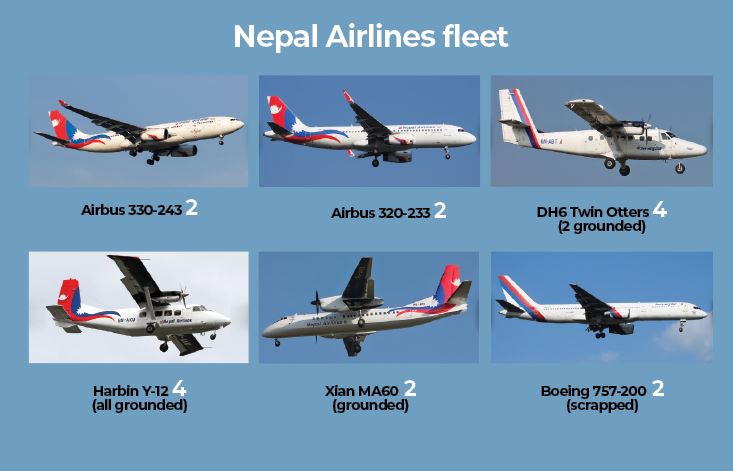
Fleet Diversification Over the Decades
Over the years, Nepal Airlines has seen a significant transformation in its fleet, reflecting the changing needs and technological advancements in aviation. The airline’s fleet has evolved from a mix of politically influenced donations to a more strategic selection of aircraft. This diversification has been crucial in maintaining the airline’s competitive edge and expanding its service offerings.
- Douglas DC-3 (1958-1973)
- Pilatus Porter PC-6 (1961 -1998)
- Fong Shu Harvester AN- 2 ( 1963-1965)
- Fokker Friendship F-27 ( 1966-1970)
- Hawker Siddley HS-748 Avro ( 1970)
- Twin Otter DHC-6 ( 1971)
- Boeing 727-100 (1972-1993)
- Boeing 757-200 (1987-2017)
- Moder Ark 60 (MA60) (2014)
- Harbin Y-12 (2014-2020)
- Airbus A320-200s (2015- Present)
- Airbus A330-200s (2018- Present)
The fleet’s evolution is a testament to the airline’s adaptability and commitment to modernization. The introduction of various aircraft types over the decades has allowed Nepal Airlines to cater to diverse route demands, from short-haul domestic flights to long-haul international destinations.
With each fleet update, Nepal Airlines has aimed to improve operational efficiency and passenger experience, ensuring that each step forward aligns with global aviation trends and customer expectations.
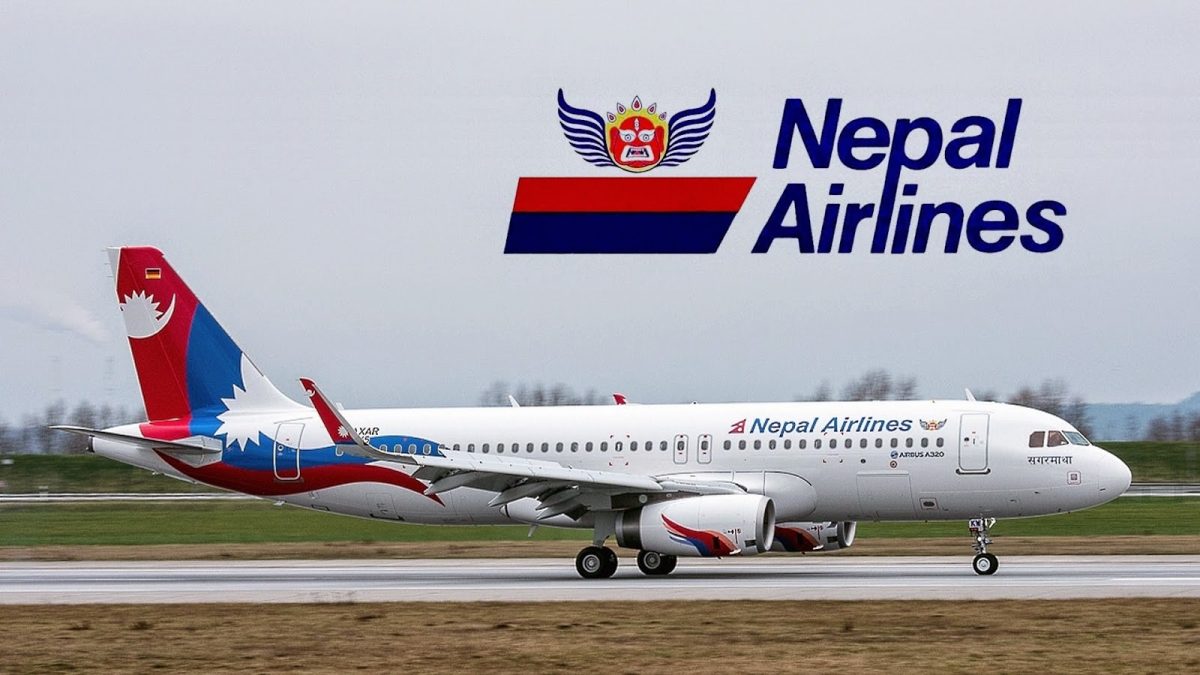
Strategic Partnerships and International Relations
Collaboration with International Airlines
Nepal Airlines Corporation (NAC) has been proactive in forging strategic partnerships with international airlines to enhance its global connectivity. Collaborations with other carriers have been instrumental in expanding NAC’s reach, allowing passengers to travel seamlessly across different regions. One such partnership is the codeshare agreement with Druk Air, which has facilitated increased travel options for customers.
In recent years, NAC has made significant strides in its international operations. For instance, the acquisition of two Airbus A330-200s in 2018 marked a milestone in the airline’s history, enabling the expansion of services to long-haul destinations such as Seoul Incheon, Tokyo, and Sydney. This move underscores NAC’s commitment to broadening its international footprint and catering to the growing demand for air travel.
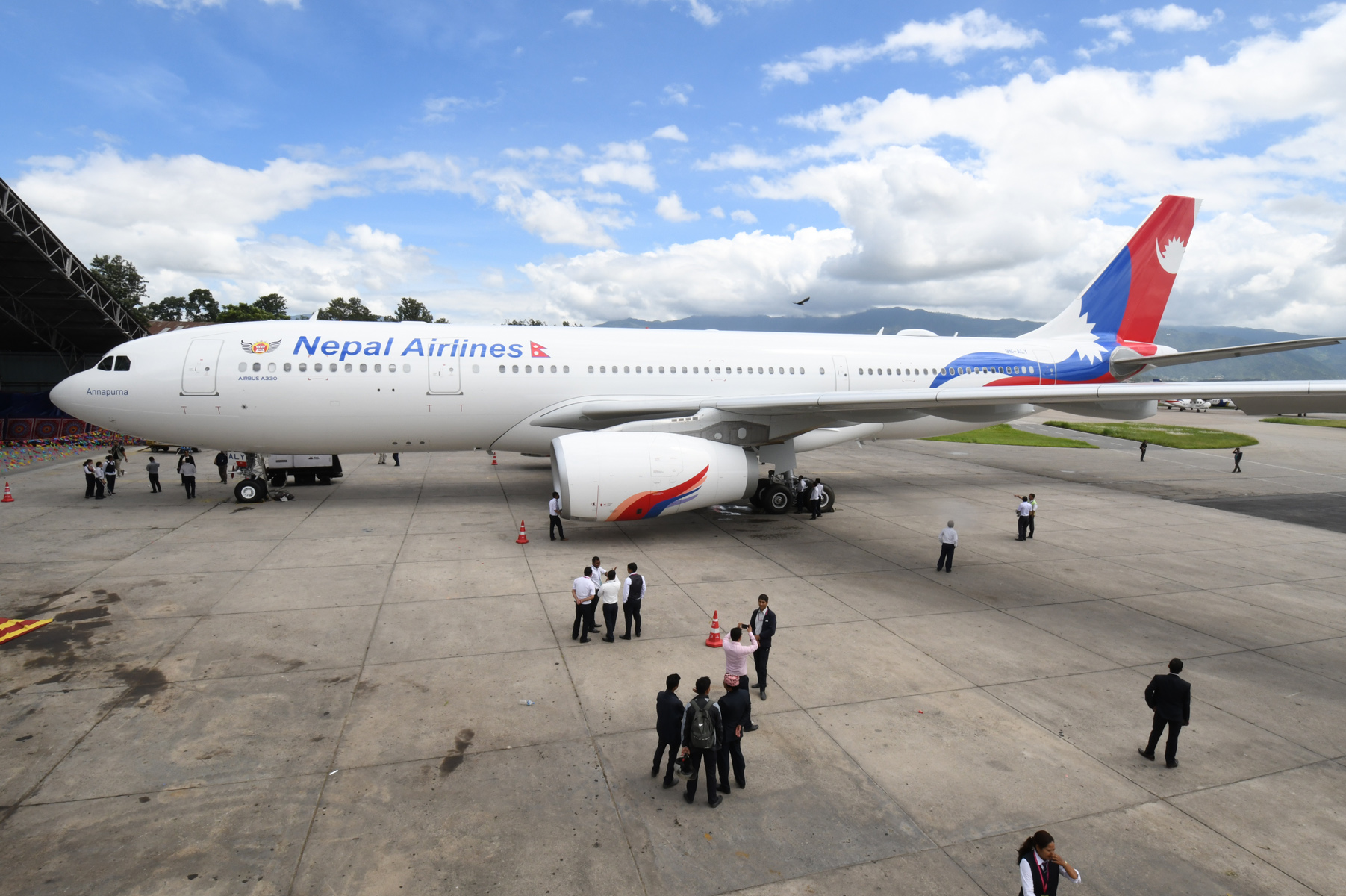
NAC’s approach to international tenders also reflects its global outlook. The airline’s invitation for international bids to lease two narrow-body aircraft is a clear indication of its intent to modernize and expand its fleet to meet international standards.
The table below summarizes NAC’s current international collaborations and fleet enhancements:
| Year | Event | Significance |
|---|---|---|
| 2018 | Acquisition of Airbus A330-200s | Expansion to new international destinations |
| 2024 | International tenders for leasing | Fleet modernization and expansion |
NAC’s journey towards becoming a competitive international airline continues, with a focus on strategic partnerships that promise a brighter future for the airline and its customers.
Service Expansion to Remote Destinations
Nepal Airlines Corporation (NAC) has been steadfast in its commitment to serve the farthest corners of the nation. In a bid to enhance its capabilities for remote area flights, NAC is progressing toward the acquisition of three Twin Otteraircraft. This move is set to significantly bolster the airline’s reach to Nepal’s challenging terrains.
With the strategic addition of these aircraft, NAC aims to provide full service to all 23 remote destinations. The expansion is not just about connecting places; it’s about connecting people, fostering trade, and supporting local economies.
The airline’s dedication to remote area service is further exemplified by its plans to hire two narrow-bodies, and the training of five pilots specifically for these operations. This initiative reflects NAC’s resolve to ensure that even the most isolated regions are integrated into the national and global transport network.
- List of Remote Destinations Currently Served by NAC:
- Jomsom
- Lukla
- Rara
- Dolpa
- Simikot
- Phaplu
- Taplejung
Joint Ventures and Management Agreements
Nepal Airlines has explored various forms of partnerships to enhance its operational capabilities and extend its global reach. Joint ventures and management agreements have been pivotal in this strategy, allowing the airline to share resources and expertise with international counterparts. One such partnership is with Druk Air, which has facilitated improved connectivity in the region.
The airline’s fleet, a mix of aircraft ranging from the DHC-6 Twin Otter to the Airbus A330-200, has benefited from these collaborative efforts. These partnerships have not only helped in fleet expansion but also in the adoption of new technologies and services, such as the introduction of Shangri-La Class for a more luxurious travel experience.
The strategic alliances and equity investments have been instrumental in shaping the airline’s growth trajectory, enabling it to compete more effectively in the international aviation market.
While the specifics of these agreements are often complex, they typically aim to optimize the use of the airline’s assets and improve service quality. The following list highlights some key aspects of these partnerships:
- Codeshare agreements to expand route networks
- Joint ventures for resource sharing
- Alliances to strengthen market presence
- Equity investments for financial stability

Challenges and Controversies
Competition with Emerging Airlines
As the aviation market in Nepal liberalized in the early 1990s, Nepal Airlines faced new challenges with the emergence of several domestic competitors. Companies such as Necon Air, Cosmic Air, Everest Air, Buddha Air, Yeti Airlines, and Sita Air began to claim significant portions of the domestic air traffic, with four of these competitors accounting for 70 percent of the market by 1997.
The airline’s market share, which once peaked at 50 percent in 1979, saw a decline as tourist numbers grew and more players entered the field. The competition was not limited to domestic carriers; international airlines like Indian Airlines Corporation, Singapore Airlines, and Lufthansa also vied for a piece of the lucrative Nepalese market.
In the face of intensifying competition, Nepal Airlines had to reassess its strategies and seek new ways to maintain its relevance in the industry.
Government’s Privatization Efforts
In the early 2000s, the Government of Nepal initiated a significant shift in the management of Nepal Airlines, aiming to address the airline’s financial challenges. In 2004, the decision to sell a 49% stake to the private sector was a strategic move to infuse much-needed capital and expertise. Despite retaining a majority share, the government sought to relinquish management control, hoping that privatization would lead to innovation and efficiency.
The privatization efforts, however, were not without controversy. Allegations of corruption and mismanagement frequently marred the airline’s reputation. One notable incident involved the former chairman, Ramagya Chaturvedi, who faced legal consequences for his actions. The airline’s history of scandals, including the contentious lease of a Boeing 767, highlighted the complexities of transitioning to a privatized model.
The privatization process was envisioned as a pathway to reorganization and revitalization for Nepal Airlines, yet it also opened the door to scrutiny and public debate over the airline’s strategic direction and governance.
Corruption Scandals and Management Issues
The turn of the millennium marked a challenging period for Nepal Airlines, with corruption scandals casting a shadow over its operations. Allegations of cronyism and financial mismanagement surfaced, implicating figures at the highest levels of management. One notable incident involved the controversial lease of a Boeing 767, which was criticized for its high operational costs and questionable necessity, given the underutilization of the existing fleet.
Financial struggles have been a recurring theme for the airline, exacerbated by a series of scandals. Despite efforts to secure financing and implement reforms, the airline’s reputation has suffered, leading to calls for privatization and management overhaul. The table below summarizes some of the key controversies that have plagued the airline:
| Year | Incident | Outcome |
|---|---|---|
| Early 1990s | Appointment allegations involving Dinesh Dhamija | Court settlement |
| 2000 | Lauda Air lease scandal | Suspension of RNAC chairman |
| 2004-2005 | Privatization efforts and corruption charges | Jailing of former chairman |
The airline’s history is marred by episodes of corruption, which have not only tarnished its image but also impacted its financial health and operational efficiency.
Operational Hubs and Network Connectivity
Tribhuvan International Airport as the Main Base
Tribhuvan International Airport (TIA) serves as the central hub for Nepal Airlines, facilitating both their international and domestic operations. As the primary gateway to Nepal, TIA is pivotal in connecting the country with the rest of the world. The airport is not only a hub for the flag carrier Nepal Airlines but also for Himalaya Airlines and several domestic carriers such as Buddha Air.
Nepal Airlines operates flights to 11 international destinations and several domestic ones from TIA. The airline’s network is further supported by regional hubs located at Biratnagar, Nepalgunj, and Pokhara airports. This strategic positioning allows for a comprehensive coverage of both international and domestic routes, ensuring accessibility to various parts of the country.
The acquisition of two Airbus A330-200s in 2018 marked a significant step in expanding the airline’s international reach, with plans to include cities like Seoul, Tokyo, and Sydney in its network.
The table below provides a snapshot of Nepal Airlines’ operational hubs and their roles:
| Hub Airport | Role |
|---|---|
| Tribhuvan International Airport | Main base for international and domestic flights |
| Biratnagar Airport | Regional hub for eastern Nepal |
| Nepalgunj Airport | Regional hub for western Nepal |
| Pokhara Airport | Regional hub for central Nepal |
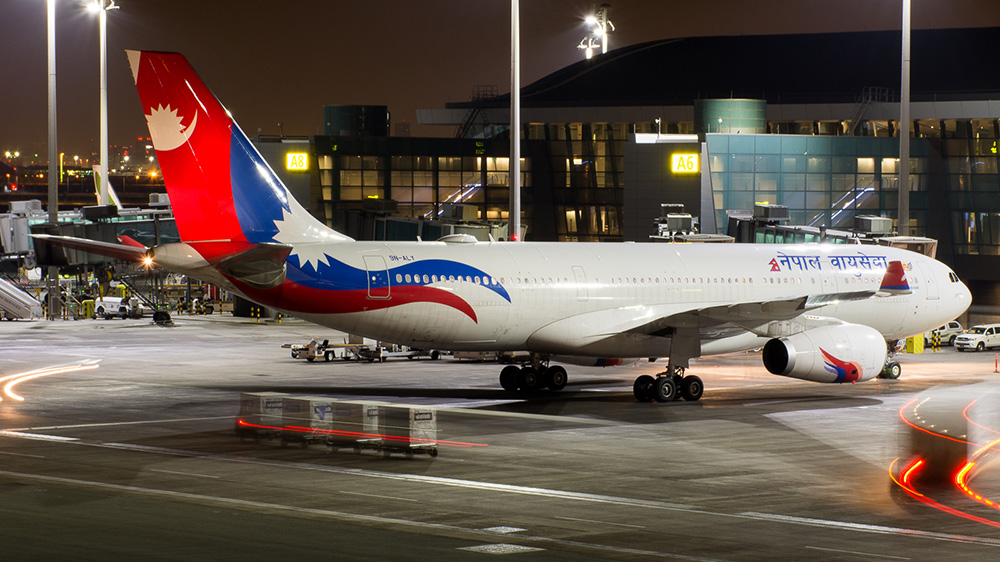
Secondary Hubs and Their Roles
While Kathmandu’s Tribhuvan International Airport serves as the primary hub for Nepal Airlines, the airline has also established secondary hubs to enhance its network connectivity. These hubs play a crucial role in facilitating regional travel and supporting the main base during peak travel seasons.
- Pokhara Airport: A gateway to the Annapurna region, catering to tourists and trekkers.
- Biratnagar Airport: Serves the eastern part of Nepal, connecting it to the capital and other major cities.
- Nepalgunj Airport: Acts as a bridge for flights to the remote Western regions and neighboring India.
The strategic positioning of these hubs allows for efficient management of passenger flow and aircraft deployment. For instance, the Pokhara hub is instrumental in distributing tourist traffic, thereby reducing congestion at the main base. Moreover, these hubs are essential for the airline’s operations in remote airfields, which often lack infrastructure but are vital for the country’s connectivity.
Domestic and International Route Networks
Nepal Airlines, once known as Royal Nepal Airlines, has a rich history of connecting various destinations within and beyond the country’s borders. With its main hub at Tribhuvan International Airport, the airline has expanded its network to include more than 20 domestic destinations, ensuring that even the most remote regions are accessible by air. International routes have been carefully cultivated to connect Nepal with key global cities, enhancing the country’s international presence.
The airline’s domestic operations are characterized by economy class service, catering to short-duration flights with basic amenities. For international travel, passengers can experience different cabin classes, with services tailored to longer journeys. Here is a snapshot of Nepal Airlines’ network connectivity:
- Main Hub: Tribhuvan International Airport
- Regional Hubs: Biratnagar, Nepalgunj, Pokhara
- International Destinations: 11
- Domestic Destinations: 20+
Nepal Airlines’ strategic route expansion has played a pivotal role in promoting tourism and facilitating trade, significantly contributing to the nation’s economic development.
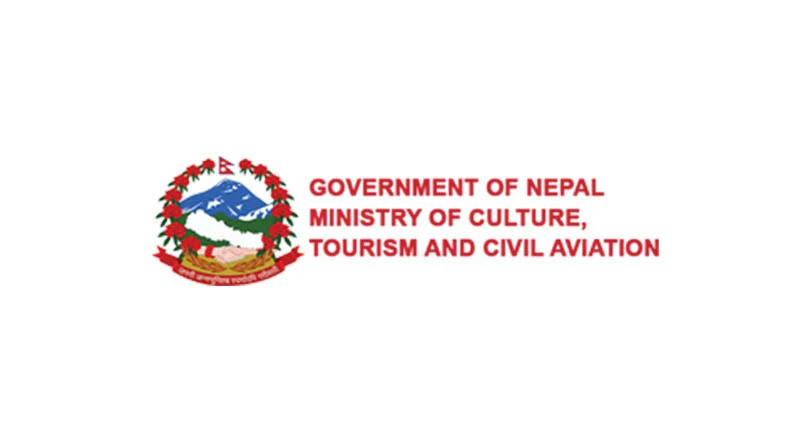
Tourism and Economic Impact
Role in Promoting Tourism in Nepal
Nepal Airlines Corporation (NAC) has been a cornerstone in the development of tourism in Nepal. Efficient air connectivity is crucial for a landlocked country like Nepal, where the majority of tourists arrive by air. In 1985, Nepal saw 181,000 tourists, with a significant 80 percent arriving by air, showcasing the pivotal role of air transportation in tourism.
The airline’s contribution to tourism is not just about the number of flights but also about the promotion of Nepal as a destination. Events like the PATA Nepal Chapter’s commitment to ongoing tourism marketing are essential in maintaining Nepal’s visibility on the global stage. The airline’s efforts complement the government’s initiatives to enhance economic diversification through increased international trade.
- In 2015, NAC transported 253,658 international travelers, marking a 22.87 percent increase from the previous year.
- The same year, domestic air passenger numbers rose by 21.60%, indicating a growing trend in internal tourism and mobility.
Nepal Airlines has not only facilitated the influx of tourists but has also been instrumental in promoting the country’s rich cultural heritage and natural beauty, contributing significantly to the national economy.
Contribution to National Economy
Nepal Airlines Corporation (NAC) has been a pivotal player in the economic landscape of Nepal, particularly in the tourism sector. Tourism is a significant contributor to the nation’s GDP, and NAC’s role in facilitating travel has been crucial. The airline’s services enable the flow of tourists, which in turn supports local businesses and employment.
Tourism revenues are bolstered by the airline’s capacity to carry a substantial portion of international visitors to Nepal. Historical data shows that in 1985, Nepal had 181,000 tourist visitors, with 80 percent arriving by air and NAC carrying 38 percent of these passengers. This trend underscores the airline’s impact on the economy through the tourism channel.
The consistent growth in passenger numbers reflects positively on the economic benefits derived from the airline’s operations. For instance, in 2015, NAC experienced a significant increase in travelers, with domestic air passengers rising by 21.60% compared to the previous year.
The airline’s contribution extends beyond tourism. It plays a role in the transportation of goods and in connecting remote regions of Nepal, thus contributing to the overall economic development of the country.

Market Share and Passenger Trends
Nepal Airlines has experienced fluctuating market share and passenger numbers over the years. In 2015, the airline saw a significant increase in travelers, with 253,658 passengers representing a 22.87 percent rise from the previous year. This growth, however, has not been consistent. Recent statistics indicate a concerning trend; domestic airlines, including Nepal Airlines, witnessed a sharp 7.07 percent drop in passenger growth in 2023 compared to 2022.
The market for flights in Nepal is expected to grow, with projections showing an increase to a market volume of US$135.40m by 2028.
Despite these challenges, the airline’s role in ferrying tourists remains substantial. Historically, Royal Nepal Airlines carried a significant portion of tourists arriving by air, peaking at a 50 percent market share in 1979. The competitive landscape has evolved with new entrants, but Nepal Airlines continues to adapt and strive for a larger share of the market.
Modernization and Future Prospects
Fleet Upgrades and Expansion Plans
Nepal Airlines Corporation (NAC) is actively pursuing a strategy to modernize its fleet and expand its operational capabilities. NAC has invited tenders for the wet lease of two narrow-body aircraft, aiming to enhance network expansion and operational efficiency. This move is a part of a broader initiative to meet the increasing demand for air travel within and outside Nepal.
In a recent announcement, NAC revealed plans to purchase three additional aircraft to bolster its domestic services. This decision underscores the airline’s commitment to improving connectivity and catering to the burgeoning travel needs of the Nepalese population.
The fleet expansion and modernization efforts are expected to significantly boost NAC’s competitiveness in the regional aviation market.
The table below outlines the projected additions to the fleet, reflecting NAC’s strategic approach to growth:
| Year | Aircraft Type | Quantity | Purpose |
|---|---|---|---|
| 2023 | Narrow-body | 2 (Lease) | Network Expansion |
| 2024 | Domestic Aircraft | 3 (Purchase) | Service Enhancement |
Adapting to Global Aviation Standards
In the dynamic landscape of international aviation, Nepal Airlines Corporation has been proactive in adapting to global standards. Embracing technological advancements and forming strategic partnerships have been pivotal in this transformation. A notable collaboration is with Hitit, a leading provider of airline and travel technology solutions, which marks a significant step towards modernizing operations and enhancing service quality.
To align with international best practices, Nepal Airlines has implemented several key measures:
- Upgrading its fleet to include aircraft with advanced navigation and safety features
- Training staff to comply with international service and safety protocols
- Streamlining operations to improve efficiency and reduce environmental impact
This commitment to global aviation standards is not just about compliance; it’s about ensuring the safety, comfort, and satisfaction of every passenger who flies with Nepal Airlines.
Strategies for Sustainable Growth
In the face of evolving global aviation dynamics, Nepal Airlines Corporation (NAC) is charting a course towards sustainable growth. Strategic management and marketing initiatives are pivotal in navigating the competitive skies. The airline is also prioritizing infrastructure development to accommodate future expansions.
To ensure sustained growth, the industry must transform, focusing on strategic management, marketing, and infrastructure development.
In a significant move to alleviate financial pressures, NAC has recently made substantial payments towards its debts, showcasing a commitment to fiscal responsibility. This step is part of a broader reorganization aimed at stabilizing the airline’s economic foundation.
- Emphasis on eco-friendly operations
- Expansion of service quality and reach
- Investment in staff training and development
- Adoption of advanced aviation technologies

Customer Service and In-flight Experience
Enhancing Passenger Comfort
Nepal Airlines Corporation has consistently prioritized passenger comfort as a key aspect of its service. Innovations in seating and cabin layout have been central to this effort, ensuring that even the longest flights are as comfortable as possible. The airline has introduced ergonomic seats with adjustable headrests and more legroom, catering to the well-being of travelers.
To further enhance the in-flight experience, Nepal Airlines has implemented various self-service solutions. These include streamlined check-in processes and improved cabin convenience, reflecting a trend seen in the snippet about optimizing airline passenger experience in the United States. Passengers now enjoy a more personalized and efficient journey, from the airport to their final destination.
Nepal Airlines is dedicated to refining the travel experience, making each journey a memorable part of the adventure.
The table below outlines the recent improvements made to enhance passenger comfort:
| Feature | Description | Impact |
|---|---|---|
| Ergonomic Seating | Adjustable headrests and increased legroom | Improved physical comfort |
| Self-Service Kiosks | Streamlined check-in and boarding | Reduced wait times |
| In-Flight Entertainment | Upgraded systems with diverse content | Enhanced enjoyment |
By focusing on these areas, Nepal Airlines aims to set a new standard in passenger comfort, ensuring that each flight is not just a means to an end, but a pleasant part of the travel experience.
In-flight Amenities and Services
Nepal Airlines takes pride in offering a range of in-flight amenities and services to enhance the passenger experience. Economy class travelers are treated to a meal with a choice of fish, chicken, or mutton, and vegetarian options are available upon request. The airline’s Airbus A330 economy seats come equipped with an IFE system, boasting a selection of 40 Asian movies, 30 TV programs, and 20 music albums.
For those flying Shangri-La Class, the experience is further elevated with gourmet meals and a variety of complimentary beverages, including wine, cocktails, and vodka. The business class on international flights features 18 seats on the Airbus A330 and 8 seats on the Airbus A320, ensuring a comfortable and exclusive journey.
On domestic routes, where flights are typically short, passengers are offered complimentary candies and cottons to ensure a pleasant trip.
Here’s a quick overview of the in-flight services provided by Nepal Airlines:
- Economy Class: Meal with multiple options, IFE system on Airbus A330
- Shangri-La Class: Gourmet meal, complimentary drinks, exclusive seating
- Domestic Flights: Complimentary candies and cottons
Customer Feedback and Improvement Measures
Nepal Airlines Corporation recognizes the importance of data and analytics in enhancing the customer experience. By leveraging customer feedback, the airline has been able to identify key areas for improvement and implement targeted measures. Customer satisfaction is paramount, and the airline is committed to continuous improvement.
Feedback channels include direct customer surveys, social media monitoring, and review analysis. This multi-faceted approach ensures a comprehensive understanding of passenger needs and expectations. The airline has taken steps to address common concerns, such as in-flight comfort and the efficiency of check-in procedures.
In response to feedback, Nepal Airlines Corporation has introduced a series of initiatives aimed at refining the overall travel experience. These include staff training programs, upgrades to in-flight entertainment systems, and enhancements to the loyalty program.
While the airline strives to provide exceptional service, it acknowledges that there is always room for growth. Passengers are encouraged to share their experiences, both positive and negative, to help the airline evolve and better serve its customers.
Conclusion
As we reflect on the evolution of Nepal Airlines Corporation, formerly known as Royal Nepal Airlines, we are reminded of its rich history and significant role in connecting Nepal with the rest of the world. From its humble beginnings in 1958 with a single Douglas DC-3, the airline has navigated through periods of expansion, competition, and challenges, including management changes and efforts to modernize its fleet. Despite facing corruption issues and the need for strategic investments, Nepal Airlines has remained a symbol of national pride and a key player in promoting tourism and economic growth. As it continues to serve as Nepal’s flag carrier, the airline’s journey is a testament to its resilience and the enduring spirit of Nepalese aviation.
Frequently Asked Questions
When was Royal Nepal Airlines established?
Royal Nepal Airlines was established on July 1, 1958.
What was the first aircraft used by Royal Nepal Airlines?
The first aircraft used by Royal Nepal Airlines was a Douglas DC-3.
When did Royal Nepal Airlines transition to Nepal Airlines Corporation?
The exact date of the transition from Royal Nepal Airlines to Nepal Airlines Corporation is not specified in the provided information.
What type of aircraft were introduced to the fleet in the 1960s?
In the 1960s, Pilatus Porter STOL aircraft and Chinese Feng Shou-2 Harvesters were introduced to the fleet.
Which destinations did Royal Nepal Airlines connect by 1988?
By 1988, Royal Nepal Airlines connected 38 domestic and 10 international destinations, including direct flights from Nepal to Hong Kong and scheduled service between Kathmandu and Lhasa, Tibet.
What was the market share of Royal Nepal Airlines in carrying tourist passengers in 1985?
Royal Nepal Airlines carried 38 percent of tourist passengers in 1985.
What were the government’s privatization efforts for Nepal Airlines in 2004?
In 2004, the Government of Nepal decided to sell off 49% of its stake in Nepal Airlines to the private sector and hand over management control while retaining a 51% share.
What challenges did Nepal Airlines face in the 1990s and 2000s?
Nepal Airlines faced challenges from emerging competitors after the domestic air market was liberalized in 1992, as well as corruption scandals, including the jailing of a former chairman for corruption in February 2005.

